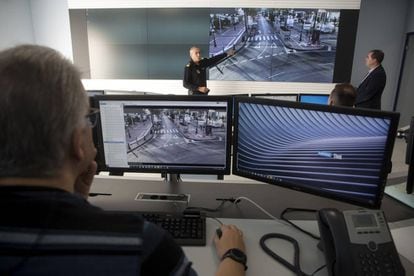Marbella, the biggest video surveillance lab in Spain
The southern Spanish city has 85 ultra-high definition cameras that use artificial intelligence software to scan hours worth of footage to identify suspects


There’s been a robbery in a shop in Puerto Banús in the southern Spanish city of Marbella. The video surveillance cameras capture an image of the thief. The following day, the same individual is walking down a nearby street. Thanks to their gait, clothes, gender, hair color and “unique facial features,” the cameras detect their presence and the police can arrest them. These images will be used as evidence when they go to trial.
For the past year, Marbella has been using the most sophisticated urban video surveillance cameras in Spain. The city may have only 85 devices compared to the 220 in La Nucía, Alicante – which has the most in the country – but it is the area with the highest number of ultra-high definition cameras, according to the US software company, Avigilon. Only the border of the Spanish exclave city Ceuta in North Africa has more sophisticated cameras. First and second division soccer stadiums also use high-tech devices. And in the Madrid region, the towns Las Rozas de Madrid and Rivas Vaciamadrid have launched similar projects.
There are still a lot of doubts about the effectiveness of facial recognition Fernando Miró, director of Crímina
Regional legislation bans the use of facial recognition and other biometric data without consent. In order to identify the face of a suspect, the cameras must analyze the faces of everyone walking around the city. Marbella is not breaking this law. But the artificial intelligence (AI) software treads close to the line with its so-called “appearance search,” which detects unique facial traits, the color of a person’s clothes, age, shape, gender and hair color. None of this information can be considered biometric; it is what a police officer would see on the street. But artificial intelligence is able to scan thousands of hours worth of video to speed up the search. The system is also able to identify the model and color of any vehicle without knowing the number plate.
In addition to the appearance search, the Avigilon software includes another special AI function: it detects unusual movement. “To avoid graffiti, we can calculate the time someone takes to pass a shop window, “ says Javier Martín, local chief of police in Marbella. “If it takes them more than 10 seconds, the camera is activated to see if they are graffiting. So far, it hasn’t been activated.”

If someone runs or loiters, or if there is a stampede or unusual movement, the corresponding camera at the control station snaps into action. And the analysis can be done in real time or on recorded images.
Extraordinary detail
The clarity of the images picked up by the 16-megapixel cameras in Marbella is astounding. Long gone are the black and white pixelated images captured by old security cameras. Now, it’s like watching high definition television. The zoom is strong enough for a menu scrawled on a blackboard outside of a restaurant to be read dozens of meters away.
Marbella had wanted to install surveillance cameras along its streets since 2005, but it was only in 2017, after several requests, that the city was granted permission. To pick the best places to install the devices Javier Martín, mapped all the incidents that had happened in the city, which runs along 27 kilometers of coastline and is home to 250,000 people. The Andalusian High Court reviewed the type of camera and where they were going to be placed. It asked for four to be removed and virtual screens to be placed in some areas so that nearby balconies were not inadvertently filmed.
Artificial intelligence is able to scan thousands of hours worth of video to speed up the search for a suspect
The first phase was implemented in October, 2018. By the summer of 2020, a second phase will see the installation of another 105 cameras, and a third phase will be launched further down the line. The fourth phase will involve a simpler kind of technology – reading number plates. Theft of expensive cars is one of the most common crimes in Marbella.
“The Marbella project has the most potential in Spain as far as the definition of the cameras and the design of the area covered are concerned,” says Cristóbal Martín, who runs Avigilon in southern Spain.
Facial recognition software is not installed in the Marbella cameras. What’s more, it is against the law to follow the face of a suspect through the streets, search for the face to see if it is in the Marbella area or compare someone’s face to a face on the government’s database. Indeed, it is not even clear whether software even has these kinds of capabilities.
“There are still a lot of doubts about the effectiveness of facial recognition,” says Fernando Miró, director of Crímina, the criminology research center at the Miguel Hernández University in Elche. It’s different with cars. In the case of vehicles, the software can follow its movement.
Avigilon finished deploying its facial recognition software this week. This software is not allowed to be installed in municipal cameras. “We have private installations waiting to incorporate it,” says Cristóbal Martín. “It’s for those installations alone and cases that comply with the General Data Protection Regulation (GDPR), which are mostly private too. It will only be used in cities and public buildings when these are covered by the law or authorized by the national security forces.”
The Marbella project has the most potential in Spain
Cristóbal Martín, Avigilon
This opens up a gray area about when facial recognition can be used. For example, it can be used when it comes to the investigation of a specific crime and there is a real risk, as long as it is in line with the seriousness of the crime, and is just an exception to the GDPR’s ban on the use of biometric data, according to Miró.
Once there are thousands of cameras around Spain with software similar to Avigilon, will the police be able to get legal justification to activate the indiscriminate search for a suspect’s face? It would seem so.
In Europe in recent months, there have been some notable controversies: two cameras around London’s King’s Cross have been using facial recognition technology for two years, and a Swedish school was fined by the EU for using facial recognition despite having the students’ consent.
The problem with the indiscriminate search is that to detect a suspect, the software has to analyze everybody. These images will go to a data base that might have a special charter. “The problem is gathering information and creating metrics with the data,” says Paula de la Hoz, a cybersecurity consultant with Capgemini Invent. “We will lose control of our biometric security. I always keep it in mind that these databases remain.”
Facial recognition in Madrid
Facial recognition cameras have been installed at the Ifema convention center in Madrid. It is part of a growing list of private companies that are now using the high-tech software. But according to sources from the sector, many clients do not want the public to know they are using facial recognition. The operator of the bus station Estación Sur is one of the few companies that has voluntarily admitted that they have installed the technology. According to the operators, facial recognition cameras deter pickpockets and other thieves. In 2010, the bus terminal was receiving five reports a day. In the first seven months of 2019, it has received just seven.
English version by Heather Galloway.












































